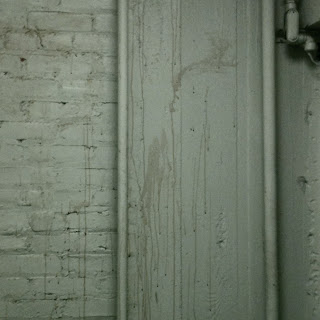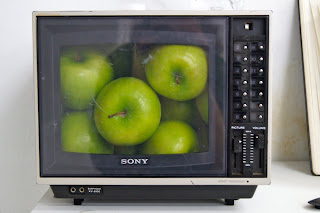Monday, December 19, 2011
Romancing the LookyLoos- David Hickey
Cage
DJ Spooky-Rhythm Science
Bachelard Reading
Friday, December 16, 2011
Things I needed to post!
John Cage:
I loved all the talk about method and process, sets of rules and processes that he made for himself, especially concerning layout. Something I was exploring around the time I read this reading. Establish a set of rules, and then set out to break them. Art impacting life is something I need to practice more, and not letting my life impact my art.
DJ Spooky:
The thought of remixing and sampling obviously is something I firmly believe in and this confirms my beliefs. This was easy to read for me. I really liked the part about automatic writing; this is something I also do often. I have a tendency to do some automatic paintings that don’t necessarily end up right side up, sometimes its good to get some shit out and fall on your ass at the same time…
Rings of Saturn:
I’m glad I didn’t read this when I was depressed… I read this reading on pain medication after being in the hospital, so I found the hospital part really funny. It was not easy for me to relate to Flaubert's problem, I’m not sensitive and I could never be confined anywhere, nonetheless my couch. I was pretty turned off and it couldn’t keep my attention, whoops.
Air Guitar:
Call me stupid… been done, but this reading was great. It was written in a way where I could really hold on to it. This might be because of my attachment I have with music and just being around industry and industry folk. I can actually deal with music people much better then I can deal with art people. With them its easy to convince someone that your cooler then them if you throw the intimidators on and your best “poker face” (no pun intended), considering it is the industry of cool”. With art people, its not that simple… it’s a test to see who can be more socially awkward and introverted... be cool… but don’t look it… be rich, but dress like a slob… makes a lot less sense to me and I really truly suck at it. The reading got me thinking of a world that could be flipped, where the fans are the museum goers and the artists are rock stars. You have your indie folk, your metal folk, some classic rock and some sweet hip hop. The attitude might be different, the cloths, the red carpet, the fans, the “lingo” but we are all making something that appeals to the senses. It got me thinking about my work, specifically the text work. As do most of us, I think we all listen to some form of music while we work. My list spans from Bach to Britney Spears to Bauhaus and Missy Elliott to Ministry. I see my work kind of like songs, especially those, they just have the audio missing, but if you close your eyes you know what kind of tone those lyrics go too.
Happy Holidays!
-Brett
Tuesday, December 13, 2011
alexis marcou

i greatly appreciate the craftsmanship of marcou's work, but what struck me most about this piece is the concept of things/people being encased in ice. it brings up notions of death and entrapment, which i attempt to deal with in my work. but i also find the idea of ice melting and revealing something fascinating.
janine antoni
Thursday, December 8, 2011
Wednesday, December 7, 2011
Response to Romancing the Looky-Loos
last writing
"Romancing the Looky loo's Reading response - Victoria
Is this essay saying that we let people dictate who we are and what we will become? In the beginning Hickey comments on hoe people who support do so because they want to be like you, they want to have what you have and when you don’t have that anymore then they will find someone else to aspire to be like. What I get from this is that once someone sees what they want in us they stick around and if we like that, to be followed and admired we will do what is necessary to keep it. This makes me think of the popular girls in high school. A number of girls follow one because they want to be like her and on her side. Even though they hate her they will still follow her because its the next best thing and she as the leader will do what she has to maintain her power. If I am not an artist who has followers but I “follow” contemporary artists, does that make me a spectator in Hickory’s father since of the word? One who views artist’s work because they want to be like the artist? If I see my peers work and think about it more then I liked to admit and secretly hope that I become successful before they do, what does that say about me? I do not want to be considered successful because I am followed nor would I personally see myself as successful even though that would be great. I would consider myself successful whenI can speak the world that which I want to be apart of. It is then that I will have no doubts about if I am a spectator or an artist.
Weekly artist Andrea Zittel - Victoria
 I was looking through Andrea Rosen Gallery for information on the Reception thats happening for Roni Horn, and I came across this artist. I just think this is a beautiful piece.
I was looking through Andrea Rosen Gallery for information on the Reception thats happening for Roni Horn, and I came across this artist. I just think this is a beautiful piece.
Weekly work - victoria
Crit work - Victoria
Tuesday, December 6, 2011
Monday, December 5, 2011
artist, Kaye Donachie
reading response
This reading resonated with my recent questioning of the expected viewing audience for produced work. The structure of school permits the expectance of weekly, educated discussion about work, which is a main highlight of being a student. The awareness of school ending brings up the responsibility we each have of finding our own satisfaction with our practice, and the necessity of finding answers to our own questions as they develop and unfold. The things we make are questions and answers in themselves that only lead to further questioning, leaving artists in a constant snowball effect of development.
It will always be strange to separate the world of creation from that of presentation, I’m not sure if the translation of the mentality of creation can communicate authentically in the viewing process. Success of the maker’s mind to be viewed through each piece is perhaps the highest goal of art, but there are so many aspects of the creation process that are inevitably lost when the piece is hung and separated from the maker. These separations are discussed in the reading, when the continuously changing audience shifts more and more from personal to estranged as the popularity rises. Widespread recognition is a primary goal for most artists, but the catch-22 is the expanding disconnect that arrives with the recognition. Dave Hickey acknowledges this well with the closing statement on page 154, “You may be assured that what is being glorified in public splendor is just the residue, a mere simulacrum from which disinterested spectators may infer the experience of participants.”
Weekly Drawing

 The artist I've included this week is Mark Bradford (top), whose immense collages resemble city plans or aerial views of urban environments. He also collages in bits of newspaper, magazines, comics, and other found material, which one can see when looking up close at the work. My drawing (bottom) this week is a larger sized web drawing, upon which I have made a variety of gestures, which serve to contrast the systematic arrangement of the lines embossed into the paper and to build a relationship between digital and analog ideas, which are played out upon the surface.
The artist I've included this week is Mark Bradford (top), whose immense collages resemble city plans or aerial views of urban environments. He also collages in bits of newspaper, magazines, comics, and other found material, which one can see when looking up close at the work. My drawing (bottom) this week is a larger sized web drawing, upon which I have made a variety of gestures, which serve to contrast the systematic arrangement of the lines embossed into the paper and to build a relationship between digital and analog ideas, which are played out upon the surface.
Response to "Air Guitar": Romancing the Looky-Loos
What Hickey identifies in his writing, which is the dilemma of the famous artist and the issues of ‘selling out’ and fan relations, I think is a little odd to think of in terms of being a visual artist. For performing artists and those in the entertainment industry, this particular section of Hickey’s book was relevant, I think. But another idea that Hickey introduces that I do agree with is the notion that all of the big, important events/exhibitions/displays/etc. in any artistic culture boil down to the informal relations that preceded their advent. I thought it was so pertinent that he mentioned the mentality of the young artists he encountered, all of whom seemed to have the belief the artist is in a group of ‘others’ that are excluded from the rest of society. It raised a question for me as to who I make connections with and what kind of people I think are important to show my artwork. After reading Hickey’s work, it seemed to me that even showing my work in a forum that is mostly artists isn’t such a bad option – someone within that group is bound to have friends or a connection to someone of importance.
I also enjoyed the phrase, “spectator-food’, which I took to imply that once one’s work has reached a broader public domain, or, as Hickey says, “the domain of normative expression”, wherein one’s art has transcended one’s control. This idea reminds me of something that Francis Tucker has told me several times over, which is basically the same idea: Once you sell an artwork or loan it to whomever or whatever institution, it is totally out of your control. The art, at that point, becomes more autonomous and the artist does not determine its life anymore. Fortunately for the artist, Hickey suggests that the moment these kinds of things happen that the artist should move on. I agree with his idea, and I don’t think that ‘moving on’ necessarily means starting over or beginning something drastically different. I think it’s more a matter of acceptance of the way things work.
Another line of Hickey’s that struck me was “…you may be assured that what is being glorified in public splendor is just the residue, a mere simulacrum from which disinterested spectators may infer the experience of participants”. Hickey seems to suggest here that one’s efforts, despite how genuine they may be, do not elicit the idyllic publicized situation. I think the academic institution, particularly for visual artists, does a good job of preparing the young artist for this somewhat tragic result of their future efforts. Even if Hickey’s idea is a little dismal – one can’t have the cake and eat it, too – I think it is good to be disillusioned about such fantasies sooner rather than later. After all, the fantasy of being a rock star or famous painter or whatever and being understood and having a sincere relationship to one’s fans is a little much, which makes me wonder where such an idea originated, anyway.
Overall, the reading left me with a sense of isolation as an artist. Not that my work or I exist in a bubble, but on a social level I know that I am separated from people in other fields. Contrary to the ‘fading high-school friends’ that Hickey described, I do keep in contact with a few, in order to understand what kind of work they do, and to remember what it is like to talk to someone about something that isn’t art. So I do not think the state of things, in terms of the artist and their work in relation to the rest of society, is awful. It is practically where I expected it to be, and the conversation Hickey has with Waylon Jennings only serves to underscore its reality.
Sunday, December 4, 2011
My Final Drawing Assignment
Thursday, December 1, 2011
crit piece

included in this post is my piece from this week's critique. I did the drawing from a polygonal structure that I worked through using a labyrinth floor-plan design as a means of making a drawing. I then played with edge and value to shift the image away from flatness, which led to obscuring the image of the maze and making a relationship between the larger polygonal structure and the finer linear drawing seen up close.






































